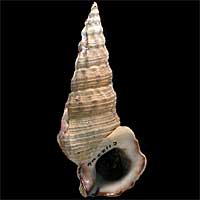|
< Previous family introduction |
|
|||||
 |
Family Batillariidae Southern mud whelks
|
|||||
|
On mud flats in estuaries and coastal lakes in NSW the southern mud whelks are the most common and obvious of molluscs. They occur in aggregations on mud or muddy sand in well sheltered areas, especially in mangrove swamps and in the mouths of coastal lakes. They prefer the zone above mid-tide level, where, as the tide recedes they produce a maze of tracks crawling over the surface searching for their food of organic detritus. They constituted an important source of food for aborigines; their shells are a common component of middens along the coast. The Batillariidae has traditionally been included as a subfamily of the Potamididae, but separated as a separate family because of anatomical, radula and sperm differences. There are only five species of the family in Australia, three of which are recorded from NSW. One of the three, Zeacumantis subcarinatus, has been introduced from New Zealand. Family References There is no consolidated reference to the family. Coverage All species of the family recorded from NSW are illustrated here. Identification Notes The Batillariidae are closely related to the Potamididae and Cerithiidae, and shells may have quite similar form. In the Batillariidae there is a strong but short anterior siphonal canal. There is a sinus (gap or broad groove) in the outer lip near the posterior end, or a narrow canal posteriorly. They are generally a temperate group that live on mud or muddy sand, although the NSW species extend into tropical Queensland. In the Cerithiidae the canal is upturned; they are a tropical group that prefers clean sand. Some of the Potamididae have identical shell characters to the Batillariidae, and they occupy the same type of habitat, but they are a tropical group, not reaching southwards into NSW.
|